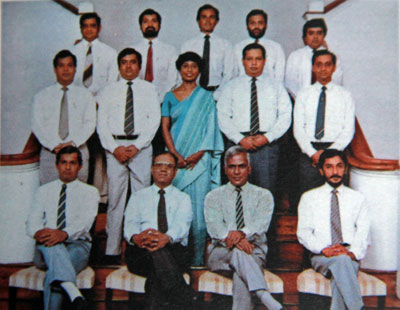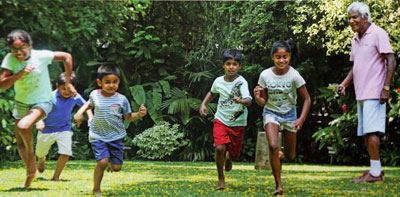“They call him Ken: The life and times of a Corporate Colossus”
COLOMBO- “One of my vices, buddy,” laughs Ken as he chats in the corridor, smoking a cigarette.

Ken with some senior members of the JKH staff
This was a conversation, several years back, when I had gone to the staid, old but imposing John Keells Holdings office at Slave Island to interview one of the most colourful private sector leaders at the time.
Ken, to some and Bala to others, this legendary business leader’s life and times as a schoolboy rugger star, a planter par excellence and a dynamic corporate leader who helped in the transformation of John Keells in the 1980s to the country’s biggest conglomerates from a colonial-era tea broking house, has been captured in a book titled “They call him Ken: The life and times of a Corporate Colossus” which was released last week.
Authored by media personality Savithri Rodrigo, the book eloquently captures Kandiah (‘Ken’) Balendra’s best and most challenging moments of his life, his friends for life, how he met his wife, Swyrie, the apple of his eyes – son Krishan and daughter Natasha, and his grandchildren.
At one point delving into his rugby playing days, Ken talks about how he acquired the name ‘Ken’. Playing for the CR&FC (Ceylonese Rugby & Football Club), his coach asked him what day: “Balendra is difficult to remember. Don’t you have a shorter name?” Pat came the response: “Call me Ken.”
Growing up in a family of seven – three boys and two girls and their parents -, Ken’s father, Ampalavanar Kandiah, was a revenue inspector earning a monthly salary of Rs. 750, then a princely sum, according to the book. Born in Jaffna, Ken and the family then moved to Colombo, staying at 25th Lane, Colpetty where much of his early days were spent.
Going down memory lane not only on the life and times of Ken but sharing many anecdotes of encounters and conversations with friends, the book quotes Sarath Samarasinghe, a life-long friend, on their growing up days and Ken’s bicycle. “Even then Ken made his presence felt. His bicycle always made a peculiar noise with the revolution of the pedal, so wherever he was on that bicycle we all knew that Bala was very much around and on the move”.
Silver-haired ‘daddy’
While Ken strode the business world as a charismatic (made even impressive with his silver hair) and respected leader and a powerful influence behind John Keells’ transformative years, he is the quintessential family man and in recent years, being a mischievous grandpa to his five grandchildren. Much of the times he spent with his children and their children is dealt with at length in the book.
The book traces in detail the times Ken spent with many friends, growing up in the neighbourhood, schooldays at Royal College, his tea planting career and then the hustle and bustle of corporate life. Among his childhood friends was Edward, the fishmonger at the Kollupitiya market and Ratna (‘Roti’) Sivaratnam, a member along with Ken in the Royal College 1958 rugby team. Like Ken, Ratna rose to the top of the corporate world, retiring as the chairman of the Aitken Spence Group.
The book takes the reader – in fact a good read for any budding corporate executive aiming to reach the top – through many passages of Ken’s colourful life including his times as a planter and his first job at Halgolla Estate in Yatiyantota. One man who has influenced Ken’s life, according to the book, was veteran planter Sepala Illangakoon who was one of two people who interviewed Ken for the job. “He was undoubtedly the best planter that Ceylon ever produced,” Ken recalls. This was a period when the best of the best sportsmen, essentially young rugger players, were offered planting jobs and in the process, to represent several upcountry, mid and low country clubs. There were teams representing Dickoya and Dimbula, Kelani Valley among others with strong sides pitted against Colombo clubs.
Ever so grateful to whom he referred to as “my superhero”, Ken – following the death of Sepala – delivered the eulogy at the memorial service at St Michael’s Church, Polwatte in 2009. There Ken said his late ‘sir’ had died “as he had lived his life … giving very clear, detailed, and no nonsense instructions (including dictating his obituary in advance, being the typical proactive approach taken by a perfectionist)”.

Ken with his grandchildren
Good old days
To many in that ‘good, old days’ generation, this is a must read as it delves into life down lanes, ‘honking’ the girls, playing cricket, enjoying a 50-cents’ ‘thosai feed’ and those care-free days when houses had big gardens and climbing trees and plucking a guava or a mango was a standard in growing up. That was also a generation that grew up on home-spun values, discipline and keeping to time. Ken was a stickler for on-time meetings, always punctual, waiting impatiently for others who ‘strolled’ in. “You are 15 minutes late. There are 10 of us who were here on time but because of your lateness, we have lost about 150 minutes of work time,” he once told a group of late-comers
In the chapter on “Of Creepers and Crawlers”, Ken recalls the ‘hard’ life of a planter – waking up early morning for the muster, and being in the sun the whole day except for a lunch break.
Ken was (and still is) the ultimate social animal, with several pictures of this silver-haired gentleman reminiscent of a 1930s song “Silver-haired daddy of mine” by the legendary Gene Autry, dancing the night away, captured over many pages in the book.
His entry into John Keells and the many years spent there along with several other exploits in the world of business and public life accommodates a large slice of the 227-page book. From his days as a tea broker – hired in 1970 by David Blackler (chairman of John Keells before Ken) and who wrote the foreword to the book –, to Walkers Tours, “They call him Ken” captures many facets of the life of a man who has seen it all; tough times in the 1970s when import controls resulted in food shortages to the 1980s when luxury goods were found in abundance compared to earlier when you could only see it in books.
It talks about how Ken groomed a strong team at John Keells in the likes of Vivendra Lintotawela, Jagath Fernando, Susantha Ratnayake and Ajit Gunewardena, the last two who continue at the helm of the organization.
Helping Brandix
A few years ago, Ken spent time at Brandix sharing in its success into a world-class group as its founder chairman. In a tribute to his leadership, the Omar brothers (owners of the company) named the company headquarters building at Rheiland Place, Colombo 3 as the “Ken Balendra Building” in November 2016. Ken had a few complementary words to say about Brandix’s dynamic CEO Ashroff Omar. “He has all the qualities of a great CEO. In my opinion he stands out as almost the very best,” says Ken, adding: “Incidentally Ashroff was an outstanding rugby forward in his school days”.
“They calls him Ken: The life and times of a Corporate Colossus” is more than just a book on a man who was a dynamic business leader and among those who transformed Sri Lanka into a diversified economy from one that relied on agriculture-based exports. It’s a reflection of the many changes the country has seen since independence, the passage of time through the eyes of a mischievous, young rugby player who during those care-free days would never have imagined the role he eventually would play in shaping Sri Lanka’s future. (The book is available at Vijitha Yapa Bookshop.)
- Feizal


